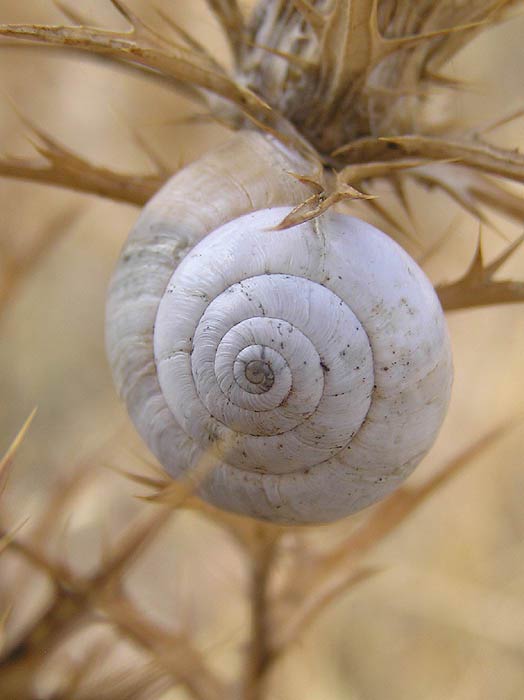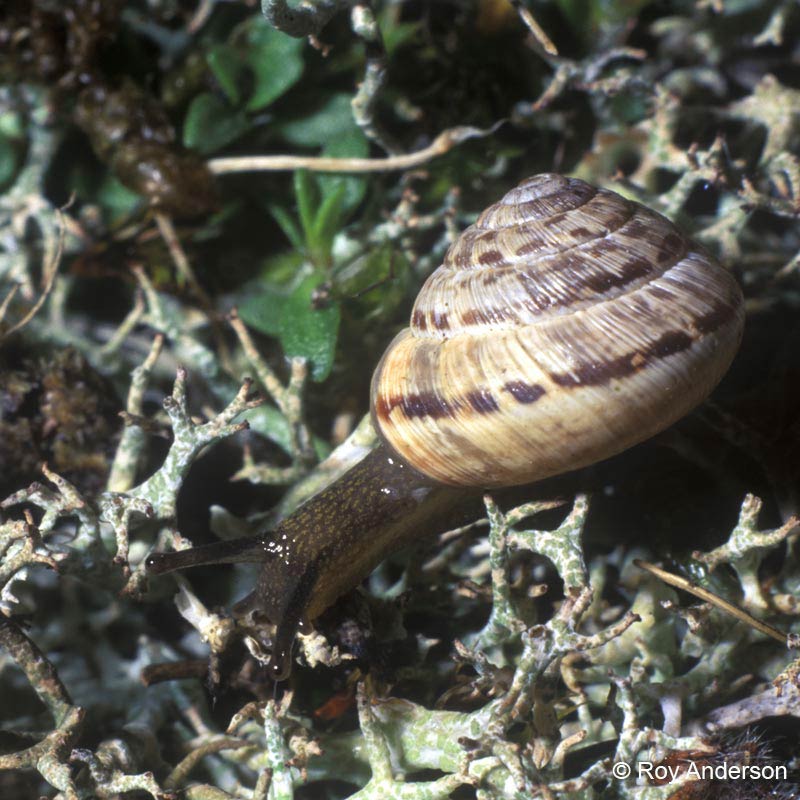Cernuella spp.
|
Cernuella neglecta. (Photo: © C. Olsen, USDA-APHIS-PPQ) |
|
Cernuella neglecta. (Photo: © L. Kolouch, www.biolib.cz) |
|
Cernuella neglecta: aggregation of snails on weedy plant. (Photo: © J. Novak, www.biolib.cz) |
|
Cernuella neglecta. (Photo: © J. Novak, www.biolib.cz) |
|
Cernuella neglecta. (Photo: © J. Novak, www.biolib.cz) |
|
Cernuella neglecta. (Photo: © Dr. Roy Anderson, MolluscIreland) |
|
Cernuella neglecta. (Photo: © Dr. Roy Anderson, MolluscIreland) |
|
Cernuella neglecta. (Photo: © Dr. Roy Anderson, MolluscIreland) |
Family
Hygromiidae
Species
Cernuella neglecta (Draparnaud, 1805)
C. virgata (DaCosta, 1778)
Common name
Cernuella neglecta: Dune snail
C. virgata: Maritime garden snail, Vineyard snail, White snail, Striped snail, Zoned snail
Description
Cernuella neglecta: The shellShell:
A hard, inflexible, calcareous or chitinous structure that vary in size and may either completely encasing the animal, covering some part of it or be internal.
of the dune snail is 6-10 mm high and 9-18 mm wide, with 5-6 whorlsWhorls:
Pleural of whorl. A whorl is a complete spiral turn/growth of the shell of a mollusc. The whorls are counted from the apex outwards.
. The shellShell:
A hard, inflexible, calcareous or chitinous structure that vary in size and may either completely encasing the animal, covering some part of it or be internal.
has a white background with several brown-pink colored stripes. The apertureAperture:
The major opening of a shell that the body of the animal may be retracted.
of the shellShell:
A hard, inflexible, calcareous or chitinous structure that vary in size and may either completely encasing the animal, covering some part of it or be internal.
may have a pinkish lipLip:
The margin of the aperture, which may be sharp or thickened depending upon the species (Also see apertural lip).
on the inside. The shellShell:
A hard, inflexible, calcareous or chitinous structure that vary in size and may either completely encasing the animal, covering some part of it or be internal.
of this species is smoother and more depressedDepressed:
Shrunken below a certain level.
than C. virgata.
C. virgata: This shellShell:
A hard, inflexible, calcareous or chitinous structure that vary in size and may either completely encasing the animal, covering some part of it or be internal.
of this species may attain dimensions as large as 19 mm high and 25 mm wide, with 5-7 whorlsWhorls:
Pleural of whorl. A whorl is a complete spiral turn/growth of the shell of a mollusc. The whorls are counted from the apex outwards.
. The color of this snail's shellShell:
A hard, inflexible, calcareous or chitinous structure that vary in size and may either completely encasing the animal, covering some part of it or be internal.
is not uniform. The shellShell:
A hard, inflexible, calcareous or chitinous structure that vary in size and may either completely encasing the animal, covering some part of it or be internal.
may have dark colored stripes that may or may not be continuous (may appear as spots or bands).
Native range
C. neglecta: Mediterranean region
C. virgata: Mediterranean region and Western Europe
Distribution
Cernuella virgata:
North America:
- U.S.: North Carolina, Washington
Europe
Australia
Ecology
This group is known to be a pest of small grains and seedling production. This pest species has the potential to produce 60 eggs per clutch and as many as 40 clutches per year. This species is considered a significant agricultural contaminant of small grains due to sheer numbers of snails that occasionally aggregate on the crop. They cause significant economic losses to farmers as their aggregation on crops clog and damage machinery during harvest. The presence of large numbers of snails in harvested grain elevates the moisture content and promotes secondary infestation by fungal pathogens that produce toxin in the grain. Toxin contaminated grain is unmarketable, as it is not fit for animal and human consumption. Multiple countries have rejected shipments of grain from Australia due to contamination by this species.
Synonyms
Cernuella neglecta:
- Helix neglecta Draparnaud, 1805
C. virgata:
- Cochlea virgata Da Costa, 1778
- Helix variabilis Draparnaud, 1801
- Xerophila euxina Clessin, 1883
References
Anderson 2005Anderson 2005:
Anderson, R. 2005. An annotated list of the non-marine Mollusca of Britain and Ireland. Journal of Conchology 38: 607-637.; Barker 2002Barker 2002:
Barker, G.M. (Ed.) 2002. Molluscs as crop pests. CABI Publishing, Wallingford, UK. pp. 1-468.; Hitchcox and Zimmerman 2004Hitchcox and Zimmerman 2004:
Hitchcox, M.E. and F.J. Zimmerman. 2004. Threats to agriculture from exotic terrestrial Stylommatophora and early detection strategies. Abstracts-American Malacological Society, Sanibel. p. 42.; Kerney et al. 1979Kerney et al. 1979:
Kerney, M.P., R.A.D. Cameron and G. Riley. 1979. A field guide to the land snails of Britain and North-west Europe. Collins, London. pp. 288.; Robinson and Slapcinsky 2005Robinson and Slapcinsky 2005:
Robinson, D.G. and J. Slapcinsky. 2005. Recent introductions of alien land snails into North America. American Malacological Bulletin 20: 89-93.








